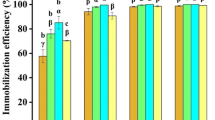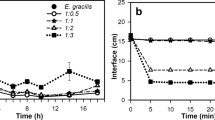Abstract
A novel fungi pelletization-assisted bioflocculation technology was developed for efficient algae harvesting and wastewater treatment. Microalga Chlorella vulgaris UMN235 and two locally isolated fungal species Aspergillus sp. UMN F01 and UMN F02 were used to study the effect of various cultural conditions on pelletization process for fungi–algae complex. The results showed that pH was the key factor affecting formation of fungi–algae pellet, and pH could be controlled by adjusting glucose concentration and fungal spore number added. The best pelletization happened when adding 20 g/L glucose and approximately 1.2E8/L spores in BG-11 medium, under which almost 100 % of algal cells were captured onto the pellets with shorter retention time. The fungi–algae pellets can be easily harvested by simple filtration due to its large size (2–5 mm). The filtered fungi–algae pellets were reused as immobilized cells for treatment wastewaters and the nutrient removal rates of 100, 58.85, 89.83, and 62.53 % (for centrate) and 23.23, 44.68, 84.70, and 70.34 % (for diluted swine manure wastewater) for ammonium, total nitrogen, total phosphorus, and chemical oxygen demand, respectively, under both 1- and 2-day cultivations. The novel technology developed is highly promising compared with current algae harvesting and biological wastewater treatment technologies in the literature.






Similar content being viewed by others
References
Brennan, L., & Owende, P. (2010). Biofuels from microalgae—a review of technologies for production, processing, and extractions of biofuels and co-products. Renewable and Sustainable Energy Reviews, 14, 557–577.
Chisti, Y. (2007). Biodiesel from microalgae. Biotechnology Advances, 25, 294–306.
Chen, X., Li, Z., Zhang, X., Hu, F., Ryu, D. D. Y., & Bao, J. (2009). Screening of oleaginous yeast strains tolerance to lignocelluloses degradation compounds. Applied Biochemistry and Biotechnology, 159, 591–604.
Wang, B., Li, Y., Wu, N., & Lan, C. (2008). CO2 bio-mitigation using microalgae. Applied Microbiology and Biotechnology, 79(5), 707–18.
Gudin, C., & Therpenier, C. (1986). Bioconversion of solar energy into organic chemicals by microalgae. Advances in Biotechnological Processes, 6, 73–110.
Li, Y., Horsman, M., Wu, N., Lan, C., & Dubois-Calero, N. (2008). Biofuels from microalgae. Biotechnology Progress, 24(4), 815–20.
Lee, A. K., Lewis, D. M., & Ashman, P. J. (2009). Microbial flocculation, a potentially low-cost harvesting technique for marine microalgae for the production of biodiesel. Journal of Applied Phycology, 21, 559–567.
Salim, S., Bosma, R., Vermuë, M. H., & Wijffels, R. H. (2010). Harvesting of microalgae by bio-flocculation. Journal of Applied Phycology. doi:10.1007/s10811-010-9591-x.
Li, Y., Horsman, M., Wu, N., Lan, C. Q., & Dubois-Calero, N. (2008). Biofuels from microalgae. Biotechnology Progress, 24(4), 815–20.
Benemann, J. R., Weissman, J. C., Koopman, B. L., & Oswald, W. J. (1977). Energy production by microbial photosynthesis. Nature, 268, 19–23.
Schenk, P. M., Thomas-Hall, S. R., Stephens, E., Marx, U., Mussgnug, J. H., Posten, C., Kruse, O., & Hankamer, B. (2008). Second generation biofuels: high-efficiency microalgae for biodiesel production. Bioenergy Research, 1, 20–43.
Benemann and Oswald (1996)
Xia, C. J., Zhang, W. D., & Hu, B. (2010). A new cultivation method for bioenergy production: cell pelletization and lipid accumulation by Mucor circinelloides. Biotechnology for Biofuels, 4, 15.
Liao, W., Liu, Y., Frear, C., & Chen, S. (2007). A new approach of pellet formation of a filamentous fungus-Rhizopus oryzae. Bioresource Technology, 98, 3415–3423
Metz, B., & Kossen, N. W. F. (1977). The growth of molds in the form of pellets—a literature review. Biotechnology and Bioengineering, 19(6), 781–799.
Nielsen, J., & Carlsen, M. (1996). Fungal pellets. In R. G. Willaert, G. V. Baron, & L. De Backer (Eds.), Immobilised living cell systems (pp. 273–293). New York: Wiley.
Papagianni, M. (2004). Fungal morphology and metabolite production in submerged mycelial processes. Biotechnology Advances, 22, 189–259.
Znidarsic, P., Komel, R., & Pavko, A. (1998). Studies of a pelleted growth form of Rhizopus nigricans as a biocatalyst for progesterone hydroxylation. Journal of Biotechnology, 60, 207–216.
Znidarsic, P., Komel, R., & Pavko, A. (2000). Influence of some environmental factors on Rhizopus nigricans submerged growth in the form of pellets. World Journal of Microbiology and Biotechnology, 16, 589–593.
Van Sjijdam, J. C., Kossen, N. W. F., & Paul, P. G. (1980). An inoculum technique for the production of fungal pellets. European Journal of Applied Microbiology and Biotechnology, 10(3), 211–221.
Smith, D., Muscatine, L., & Levis, D. (1969). Carbohydrate movement from autotrophs to heterotrophs in parasitic and mutualistic symbiosis. Biological Reviews, 44, 17–90.
Van Etten, J. L., Lane, L. C., & Meints, R. H. (1991). Viruses and viruslike particles of eukaryotic algae. Microbiological Reviews, 55(4), 586–620.
Li, Y., Zhou, W., Hu, B., Min, M., Chen, P., & Ruan, R. (2011). Integration of algae cultivation as biodiesel production feedstock with municipal wastewater treatment: Strains screening and significance evaluation of environmental factors. Bioresource Technology. doi:10.1016/j.biortech.2011.09.064.
Wang, L., Min, M., Li, Y., Chen, P., Chen, Y., Liu, Y., Wang, Y., & Ruan, R. (2009). Cultivation of green algae Chlorella sp. in different wastewaters from municipal wastewater treatment plant. Applied Biochemistry and Biotechnology. doi:10.1007/s12010-009-8866-7.
Tam, N. F. Y., Lau, P. S., & Wong, Y. S. (1994). Wastewater inorganic N and P removal by immobilized Chlorella vulgaris. Water Science and Technology, 30, 369–374.
Jimenez-Perez, M. V., Sanchez-Castillo, P., Romera, O., Fernandez-Moreno, D., & Perez-Martinez, C. (2004). Growth and nutrient removal in free and immobilized planktonic green algae isolated from pig manure. Enzyme and Microbial Technology, 34, 392–398.
Smidsrod, O., & Skjak-Braek, G. (1990). Alginate as immobilization matrix for cells. TIBTECH, 8, 71–78.
Ruiz-Marin, A., Mendoza-Espinosa, L. G., & Stephenson, T. (2010). Growth and nutrient removal in free and immobilized green algae in batch and semi-continuous cultures treating real wastewater. Bioresource Technology, 101, 58–64.
Lau, P. S., Tam, N. F. Y., & Wong, Y. S. (1997). Wastewater nutrients (N and P) removal by carrageenan and alginate immobilized Chlorella vulgaris. Environmental Technology, 18, 945–951.
Chevalier, P., & De la Noüe, J. (1985). Wastewater nutrient removal with microalgae immobilized in carrageenan. Enzyme and Microbial Technology, 7, 621–624.
Zhou, W. G., Li, Y., Min, M., Hu, B., Chen, P., & Ruan, R. (2011). Local bioprospecting for high-lipid producing microalgal strains to be grown on concentrated municipal wastewater for biofuel production. Bioresource Technology, 102(13), 6909–6919.
Hach. (2008). Procedure manual. Loveland: Hach.
Miller, G. L. (1959). Use of dinitrosalicylic acid reagent for determination of reducing sugar. Analytical Chemistry, 31, 426–432.
Liu, Y., Liao, W., & Chen, S. (2008). Co-production of lactic acid and chitin using a pelletized filamentous fungus Rhizopus oryzae cultured on cull potatoes and glucose. Journal of Applied Microbiology, 105, 1521–1528.
Foster, J. W. (1949). Chemical activities of fungi. New York: Academic.
Gibbs, P. A., Seviour, R. J., & Schmid, F. (2000). Growth of filamentous fungi in submerged culture: problems and possible solutions. Critical Reviews in Biotechnology, 20, 17–48.
Kotzabasis, K., Hatziathanasiou, A., Bengoa-Ruigomez, M. V., Kentouri, M., & Divanach, P. (1999). Methanol as alternative carbon source for quicker efficient production of the microalgae Chlorella minutissima: role of the concentration and frequency of administration. Journal of Biotechnology, 70, 357–362.
Endo, H., Hosoya, H., & Koibuchi, T. (1977). Growth yield of Chlorella regularis in dark-heterotrophic continuous culture using acetate. Journal of Fermentation Technology, 55, 369–379.
Lusk, P. (1998). Methane recovery from animal manures the current opportunities casebook. National Renewable Energy Laboratory, NREL/SR-580-25145, September.
Cheng, J., & Liu, B. (2002). Swine wastewater treatment in anaerobic digesters with floating medium. Transactions of ASAE, 45, 799–805.
Wang, L., Li, Y., Chen, P., Min, M., Chen, Y., Zhu, J., & Ruan, R. R. (2010). Anaerobic digested dairy manure as a nutrient supplement for cultivation of oil-rich green microalgae Chlorella sp. Bioresource Technology, 101, 2623–2628.
Tam, N. F. Y., & Wong, Y. S. (1990). The comparison of growth and nutrient removal efficiency of Chlorella pyrenoidosa in settled and activated sewages. Environmental Pollution, 65, 93–108.
Reeves, T. (1972). Nitrogen removal: a literature review. Journal of the Water Pollution Control Federation, 44, 1895.
Matusiak, K., Pryztocka-Jusiak, M., Leszczynska-Gerula, K., & Horoch, M. (1976). Studies on the purification of wastewater from the nitrogen fertilizer industry by intensive algal cultures. II: Removal of nitrogen from wastewater. Acta Microbiologica Polonica, 25, 361–74.
Lau, P. S., Tam, N. F. Y., & Wong, Y. S. (1995). Effect of algal density on nutrient removal from primary settled wastewater. Environmental Pollution, 89, 59–66.
Woertz, I., Feffer, A., Lundquist, T., & Nelson, Y. (2009). Algae grown on dairy and municipal wastewater for simultaneous nutrient removal and lipid production for biofuel feedstock. Journal of Environmental Engineering, 135(11), 1115–1122.
Song, Y., Hahn, H. H., & Hoffmann, E. (2002). Effect of solution conditions on the precipitation of phosphate for recovery: a thermaldynamic evaluation. Chemosphere, 48, 1029–1034.
Xin, B. X., Xia, Y. T., Zhang, Y., Aslan, H., Liu, C. H., & Chen, S. (2012). A feasible method for growing fungal pellets in a column reactor inoculated with mycelium fragments and their application for dye bioaccumulation from aqueous solution. Bioresource Technology, 105, 100–105.
Du, Z. Y., Li, Y. C., Wang, X. Q., Wan, Y. Q., Chen, Q., Wang, C. G., Lin, X. Y., Chen, P., & Ruan, R. (2011). Microwave-assisted pyrolysis of microalgae for biofuel production. Bioresource Technology, 102, 4890–4896.
Acknowledgments
The study was supported in part by grants from the University of Minnesota Initiative for Renewable Energy and the Environment and Metropolitan Council Environmental Services, as well as the Legislative-Citizen Commission on Minnesota Resource, and the MOE Biomass Engineering Center in China.
Author information
Authors and Affiliations
Corresponding author
Rights and permissions
About this article
Cite this article
Zhou, W., Cheng, Y., Li, Y. et al. Novel Fungal Pelletization-Assisted Technology for Algae Harvesting and Wastewater Treatment. Appl Biochem Biotechnol 167, 214–228 (2012). https://doi.org/10.1007/s12010-012-9667-y
Received:
Accepted:
Published:
Issue Date:
DOI: https://doi.org/10.1007/s12010-012-9667-y




